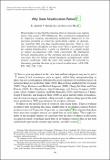Why Does Misallocation Persist?
Author(s)
Banerjee, Abhijit; Moll, Benjamin
Downloadmac.2.1.189.pdf (388.6Kb)
PUBLISHER_POLICY
Publisher Policy
Article is made available in accordance with the publisher's policy and may be subject to US copyright law. Please refer to the publisher's site for terms of use.
Terms of use
Metadata
Show full item recordAbstract
Recent papers argue that the misallocation of resources can explain large cross-country TFP differences. This argument is underpinned by empirical evidence documenting substantial dispersion in the marginal products of resources, particularly capital, in developing countries. But why does misallocation persists? That is, why don't distortions disappear on their own? This is particularly true for capital misallocation, a point we illustrate in a simple model of capital accumulation with credit constraints. We distinguish between misallocation on the intensive and the extensive margin, and show that the former should disappear asymptotically under general conditions, while the latter may persist. We conclude by discussing possible theories of persistent misallocation.
Date issued
2010-01Department
Massachusetts Institute of Technology. Department of EconomicsJournal
American Economic Journal: Macroeconomics
Publisher
American Economic Association
Citation
Banerjee, Abhijit V., and Moll, Benjamin. “Why Does Misallocation Persist?” American Economic Journal: Macroeconomics 2, 1 (January 2010): 189–206 © 2017 American Economic Association
Version: Final published version
ISSN
1945-7707
1945-7715